#so you get the minimum viable product version
Text
Lille's Kingdom Events Generator
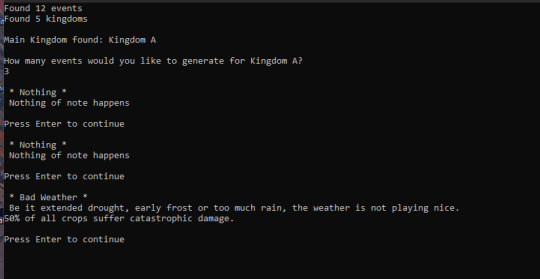
It is done-ish! And by that I mean the most basic form of this lil idea I had is ready to be unleashed on the world.
But Lille, what even is this?
Why thank you for asking, audience in my head. This is a random generator that reads in a list of events and a list of kingdoms and gives you random events that make sense to happen to said kingdoms based on requirements. Kinda like everyones beloved ROS, but instead of being for single households usually, it's on a more neighborhood scale and has a few more ways for you to influence which events roll.
I am bad at explaining it, but I promise it makes sense.
Is it necessarily a sims thing? Absolutely not! I am sure you could use this for writing prompts or random events in a TTRPG campaign or whathaveyou. But my main thought was "medieval simmers would love to have a random thing to throw natural disasters or war refugees from whatever fictional 'other' kingdoms are around in their minds at them" because I AM that medieval simmer.
So here's what you get:
An .exe which randomizes things, ala ROS, but while taking requirements into account.
An XML with sample events to generate. Are they good? Eh, they'll do. This is why it's an XML, so you can edit it and someone smarter than me can make a cooler version.
An XML with sample Kingdoms, upon which the requirements for the events are tested. They are named A,B,C,D and E and just had random-ish values thrown at them. Edit them. make them your own!
A Readme, which explains things in more detail.
Huge thanks to @clouseplayssims for throwing some inspiration in the form of every single ROS list in existence at me and being one of my initial guinea pigs, as well as enabling the silly little idea in the first place.
Alrighty, to the download, yes?
DOWNLOAD(SFS)
Note: Due to how I turned the base python code into an exe, some antiviruses flag it as a possible Trojan. I do not know how to fix that. I can only say that me and my 200 lines of code do not want to damage your computer or steal your monies, I promise.
Further note: I compiled and tested this on Windows 10. It might work on other operating systems, but i make no promises. If anyone is running into issues like that and or knows how to compile a python script, please let me know, i am more than happy to pass you the sourcecode so more people can have a functioning version of this.
I will happily answer any questions, take suggestions or try to do tech support, just let me know!
Also definitely feel free to share your edited events/kingdoms files. My examples are thrown together haphazardly and it SHOWS.
Also - you can totally use it for non medieval things. Just write modern events and ignore the fact that the program calls things in the kingdom file kingdoms. They could be cities, or planets, or whatever else you can come up with!
#sims 2 resource#i honestly dont know how to tag this#Lille's Kingdom Events Generator#this was mostly a 'can i still program' exercise and the answer is yes#but it is something i am sure at least one other person could enjoy#so i am sharing#i have some plans for some more shinies to add to this in the future#but i want to share NOW#so you get the minimum viable product version#this post is a mess i am sorry but i don't have the braincells to make it better#i am running on half a bottle of soda and 4 hours of horrible sleep
46 notes
·
View notes
Text
"Clothing tags, travel cards, hotel room key cards, parcel labels … a whole host of components in supply chains of everything from cars to clothes. What do they have in common? RFID tags.
Every RFID (Radio Frequency Identification) tag contains a microchip and a tiny metal strip of an antenna. A cool 18bn of these are made – and disposed of – each year. And with demands for product traceability increasing, ironically in part because of concerns for the social and environmental health of the supply chain, that’s set to soar.
And guess where most of these tags end up? Yup, landfill – adding to the burgeoning volumes of e-waste polluting our soils, rivers and skies. It’s a sorry tale, but it’s one in which two young graduates of Imperial College London and Royal College of Art are putting a great big green twist. Under the name of PulpaTronics, Chloe So and Barna Soma Biro reckon they’ve hit on a beguilingly simple sounding solution: make the tags out of paper. No plastic, no chips, no metal strips. Just paper, pure and … simple … ? Well, not quite, as we shall see.
The apparent simplicity is achieved by some pretty cutting-edge technical innovation, aimed at stripping away both the metal antennae and the chips. If you can get rid of those, as Biro explains, you solve the e-waste problem at a stroke. But getting rid of things isn’t the typical approach to technical solutions, he adds. “I read a paper in Nature that set out how humans have a bias for solving problems through addition – by adding something new, rather than removing complexity, even if that’s the best approach.”
And adding stuff to a world already stuffed, as it were, can create more problems than it solves. “So that became one of the guiding principles of PulpaTronics”, he says: stripping things down “to the bare minimum, where they are still functional, but have as low an environmental impact as possible”.
...how did they achieve this magical simplification? The answer lies in lasers: these turn the paper into a conductive material, Biro explains, printing a pattern on the surface that can be ‘read’ by a scanner, rather like a QR code. It sounds like frontier technology, but it works, and PulpaTronics have patents pending to protect it.
The resulting tag comes in two forms: in one, there is still a microchip, so that it can be read by existing scanners of the sort common within retailers, for example. The more advanced version does away with the chip altogether. This will need a different kind of scanner, currently in development, which PulpaTronics envisages issuing licences for others to manufacture.
Crucially, the cost of both versions is significantly cheaper than existing RFID kit – making this a highly viable proposition. Then there are the carbon savings: up to 70% for the chipless version – so a no-brainer from a sustainability viewpoint too. All the same, industry interest was slow to start with but when PulpaTronics won a coveted Dezeen magazine award in late 2023, it snowballed, says So. Big brands such as UPS, DHL, Marks & Spencer and Decathlon came calling. “We were just bombarded.” Brands were fascinated by the innovation, she says, but even more by the price point, “because, like any business, they knew that green products can’t come with a premium”."
-via Positive.News, April 29, 2024
--
Note: I know it's still in the very early stages, but this is such a relief to see in the context of the environmental and human rights catastrophes associated with lithium mining and mining for rare earth metals, and the way that EVs and other green infrastructure are massively increasing the demand for those materials.
I'll take a future with paper-based, more humane alternatives for sure! Fingers crossed this keeps developing and develops well (and quickly).
#I do really wish it could be read by regular scanners already though#that's what I thought at first#and that would've been fucking amazing#but this is still pretty cool#electronics#science and technology#green technology#ewaste#landfill#lithium#lithium mining#human rights#environment#climate action#climate hope#rfid#rfid technology#rfid tags#good news#hope
329 notes
·
View notes
Text
How to Publish a Book, pt 1
I told @tryxyhijinks I was gonna turn this into a shitpost, so here we go: how to publish an ebook in ten easy steps.
Write the book. This is, believe it or not, the fun part.
Edit the book. Slightly less easy, but you have to do this, no matter what anyone else has told you about "minimum viable product" or what have you. You can force your friends to read it, you can have a program read it aloud to you, you can read it backwards, you can hire someone to line edit your work, you can do some or most of the above, just get it edited. (Additional point: when hiring a professional, if you're happy with the plot, ask for line or copyediting; if you're not sure about plot points, ask for developmental editing; if you just need guidance, you may want to start with an editorial letter.)
Get a cover. You can make one yourself or pay someone to do it. You're going to want it to be about 1600x2500 pixels and 72 dpi. It's good to have a really nice cover, because covers sell books.
Typeset the book. I use Atticus to create an epub file. If you are also doing a print version or you are a control freak, I recommend it. Vellum and Reedsy are about the same, I think. If you have a lot of illustrations--big ones, I mean, not just an author photo--you should beg, borrow, or steal a copy of InDesign. You can use Calibre to compress your output epub file if you want to make sure you earn every available penny. However, my book is 6mb and it is about 8 cents to download. Also, if you're trying to do this on the cheap, you really can just do it in Word. The layout won't be as fancy, but you can do it. (Layout granularity, from least to most granular, is probably Word->Atticus->InDesign.)
If you want to publish under a press name that is not your name, you will need to start a business. Laws around taxes and registration may vary depending on where you are, but in general, you will want to register your name with your state or county registrar (for me, this cost $30 and I had to get a piece of paper notarized). Then you can get a business checking account (for me this part was free--I went through the bank I already have accounts with). In the US, sole proprietorships like this are taxed as pass-through entities, so you will pay personal income taxes on whatever money you make, but you don't have to pay corporate income taxes. If you are publishing books that could possibly get you sued (e.g., The Big Book of Welding While Juggling or Now You're Cooking with Napalm) you may want to form an LLC. Talk to a lawyer.
Open a KDP account. If you hate the Zon and want to only publish somewhere else (Apple Books, Kobo, Barnes and Noble, Smashwords, whatever), that's fine--the process is about the same. If you think you previously had a KDP account and then didn't use it, search your emails etc. to try to find out, because if they figure that out, they'll close both accounts and then you won't get paid.
Add your new title to the catalog (you will need to add metadata, like your name, series name if there is one, and a description of the book) and set the prices. Unless your book is super big, you'll probably earn more if you select the 70% option. For some reason, I changed a few of the prices. If you're planning to publish on several platforms, I don't recommend this--just set your price in one place and then let it convert those. Otherwise, you'll have to reinput everything over and over, because it's in the terms of service that you need to price things the same on Kobo as you do on Amazon (and so on).
Set the day of publication and tell people about it. Like your mom. Your weird aunt who's always so supportive. Your friend who has been listening to you bitch about how hard writing is for the past six months.
???
Profit.
Q: Hey, I want my book in several online stores, not just Amazon.
A: You have a few options. Draft2Digital/Smashwords and IngramSpark both distribute digitally to various places so you only have to set things up once. But they take a cut of the profit for this service. You can also set up independent accounts with each store and upload your stuff.
Q: What happens in step 9?
A: You know. Meet other indie writers and try to gain their trust. Read a lot. Work on the sequel. Get some sleep, because deadlines are exhausting, even self-imposed ones. Learn about advertising. That sort of thing.
Next time, I'll do the paper side of things.
26 notes
·
View notes
Text
Threading the Needle

Less than a single day after launch over 30 million people have joined Threads, Instagram's version of Twitter. The app is very much a minimum-viable-product copycat of Elon Musk's bird site, but their version of an MVP is still significantly more feature-rich and ready for prime-time than most other recent challengers to the throne.
The big advantage here is the use of Instagram's social graph to boost Threads signups on day one. The onboarding flow is as easy as "tap on your Instagram profile, tap on a second button to follow everyone you already follow over there, and you're done" which takes about fifteen seconds and is a significantly simpler experience than Bluesky which requires a highly coveted invite code or Mastodon which requires a whole separate blog post to explain. I think most users will discover pretty quickly that the people you followed for their photos or life updates are absolutely not the same people you want short-form text updates from... but how much does that really matter to Mark Zuckerberg who gets to boast Threads is well on its way to being the fastest growing social app of all time? Whatever gets you on board, baybee!
The app's single home feed is currently algorithm-heavy, mixing very few posts from people you follow in with a majority of posts from random users, celebrities, and brands platform-wide. The ratio is clearly way off here, and users have been loudly clamoring for a change. Adam Mosseri, Instagram and Threads' lead within Meta, has already publicly stated a feed of people you follow is incoming. Beyond that there are a lot of basic social networking features that are surprisingly absent from Threads at launch: Hashtags, usable search, post editing, post translation, alt-text on images — the group of features Mosseri has described as "on the list" feels exponentially huge. You have to wonder what the priorities will be and how long it will take to see some of these features come to the platform. Threads has a huge advantage out of the gate by tapping into Instagram's userbase of over two billion people, but retaining those users by listening to community feedback is going to be as challenging as building the app in the first place.
So it's worth keeping in mind Instagram's track record here. It's 2023 and Instagram still doesn't have an iPad app because it's "just not a big enough group of people to be a priority." Meta, one of the largest tech companies in the world, can't allocate any of their resources towards creating a high quality tablet experience for their app built around sharing and viewing photo and video? It's nonsensical! If the entire iPad userbase doesn't represent "a big enough group" to make a dedicated experience worthwhile, what does that say about accessibility features or other niche-but-important requests?
Assuming the state of Threads as it stands today will remain the same for an extended period of time, I see the app taking on a different life from just being "new Twitter." At launch, Twitter featured a reverse-chronological feed with no algorithmic intrusion, making it a great news delivery mechanism if you followed the right people. Those first few months and years of the service established the norms and future of how Twitter and the social web at large evolved. Third-party apps like Tweetie invented the pull-to-refresh interaction we see in every app on every device today. Users of Twitter began implementing hashtags as a way to more easily find like-minded community members via search, a feature which eventually became core functionality for the experience. But it all started with the launch product and timely updates from friends and proto-influencers. Twitter as a product has never really strayed too far from everyone's initial impression (despite Elon's best efforts).
By comparison, Threads is establishing its own norms in lieu of the aforementioned missing features. Brands are scrambling to figure out the right post-cadence and tone. Is posting breaking news moot in the face of an algorithmic feed? If your Threads and Instagram followers are the same, will posting images to a text-based platform feel redundant? These are questions which will be answered without intervention from Mosseri and team, and instead be dictated by the early adopters and community members who find hacky ways to actualize new methods of interaction with the toolset that is currently available in 1.0.
Am I excited that Mark Zuckerberg's Twitter has the best shot at being "the next big thing" given the many viable alternatives? Absolutely not! But there's no denying that Threads will be a hit despite Meta's track record for lying, stealing, and knowingly upending society. In the face of this, the internet-obsessed kid inside of me who loved to text 40404 to tweet in 2007 is excited to witness the birth and evolution of something that is accidentally unique because of what's missing instead of mind-numbingly samey because of what's already there.
I'm brendonbigley on Threads.
Catch you later!
19 notes
·
View notes
Text
Off With His Head!
So I put that I am a game designer in my Bio and then never actually post about game design 😅
Well I have a game coming out soon so let's change that!
This is about my game soon to be on Kickstarter (the plan is to have the preorder started before the end of the year). It’s called “Off with His Head!” and is set during the French Revolution. A fully cooperative game where you conspire to throw King Louis to the angry mob outside before he gets the idea to do the same to you.
But it wasn't always a historical game. In the beginning it wasn't even a cooperative game. Heck it barely had a theme in the first iteration! This is going to be a story about how it got from being a goofy little idea in my head to the point where it was polished enough to be spotted in the wild by a publisher and it became a game you can (soon) buy.
This story started when I was looking at a game design contest. It was held by Button Shy, and the goal was to make a game that did not use a table and had 18 cards or less as the only components.
I started thinking about a game where you stand in a circle and pass cards from hand to hand. Each player would always end up with the same number of cards after any given passing of cards. Then working from that mindset I tried to think of a reason for people to be passing cards around. I settled on the Players needing to collect 3 of the same card in hand at the same time to win. And I called it “Here Have This.” A Friendly take that game.

This is one of my first cards. This whole game was thrown together in Google Draw in an afternoon. Always remember “MVP, Minimum Viable Product” it doesn't have to be pretty, it just needs to work.
This game was in the final 10 or so of that contest but did not make it to the finish line. I was a little put out by that at the time, but looking back on it even a few weeks later I had to admit this game had some major flaws.
For starters LOOK AT HOW MUCH TEXT IS ON THAT CARD! That’s waaaaaaay to much to read and keep in your head. Funnily enough this first problem would not be corrected until the update after next. I think I was like “I will find a more concise way to say this later, the card is fine.” then the Narrator said “He didn't find a more concise way to say it.”
The bigger problems were that 1) it was very possible given the structure of the game that one player could be completely ignored for the entire game. And 2) it felt entirely random who won because it was almost impossible to plan ahead in any meaningful way.

This is King Maker!
So the next big update would fix those 2 issues. Because I was no longer under the restrictions of the contest I could use the table again! And I was no longer limited to using 18 cards or less. So I added a new card called a “Door” that sat in front of each player. If the door was on the “open” side, you could pass a card to that player. Once they got a card they flipped the door to the “Closed” side. If all doors were closed then everyone flipped the doors back to “open.” This was clunky but it did fixt the issue where players were being skipped/ignored all game.
Now to solve the planning problem I changed the victory condition so that 2 players won. The “King” and the person who made them King or “KIng Maker.” The idea would be that players can now “collude” with each other in order to win the game.
This version had lots of issues in general. Top among them being that it was still a little too random feeling for most players. I can’t remember who suggested it but someone put the idea in my head for a “robot” player at the table that everyone was trying to make “win.” And so the next big update was born!
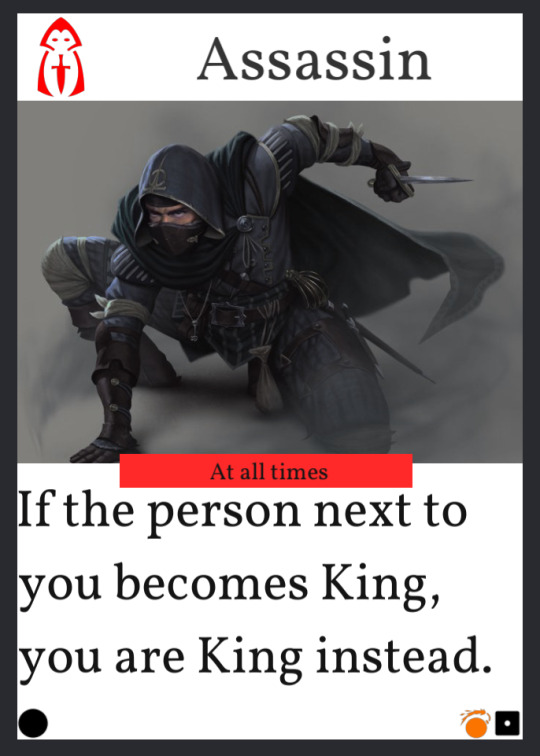

Oh look! I finally split this card in half! I remember splitting lots of cards that got too complicated, not just this one. (Heck I’m not showing you that the Assassin used to be more complex than what you see here, and half of that card’s text got split off into its own thing.)
The “Door” in the last version were way to fiddly, so I replaced them with “Chairs” the idea being that everyone was pushing people (cards) into chairs around the table, trying to influence the hand of the “Prince” (the Robot player I added to the game) so that he could be the winner of the game. The way Chairs helped improve the experience was that you would put the card passed to that player on the Chair card. Then when all the Chairs were full everyone would take the card in their chair into hand. This had the positive side effect of leaving a few cards in play in the middle of the round, so people could see how the cards were moving around the table a bit more clearly but it still left most information hidden.
This bit with the Robot and Chairs was a real game changer! It finally felt like I had something that (for the most part) worked and that I could tinker with and improve. Not just “rip the guts out and try something new” as is often the case in game design.
This also added a “Clock” to the game. After each round the clock would tick closer to midnight, if the Prince did not become King by then the Players would lose. Some cards gave you more time, and others moved time forward faster.
There was a problem that was spotted with this iteration of the game that I was about to fix. The issue was that when it came time for the Prince (the robot) to play a card he would always play to the person on his left. This made things predictable in a not fun way. I had a plan to fix it but just before I made the change I had a moment of total blind luck! A publisher happened to be at a testing event and liked the game! After talking with him I added my “Prince Fix” and got to work on a version that I could sell.


This was now “Off With His Head!” The basic rules and goals were still the same, but how it was framed was totally flipped. Now the Robot was the King of France, and the goal was to have the angry mob kill him while you and your friends snuck away. The “Clock” was replaced with a “Guillotine,” and once the “test cut” is done someone is going to die!
The “Prince Fix” is the little numbers and arrows you see on the cards. They dictate how far and in what direction the King will try to play the card. This makes how the king plays cards less predictable.
Honestly it was a lot of fun having 20+ tabs open on Wikipedia trying to find people and organizations that mapped onto the game mechanics I had already built. I also tried to include as many women as I could because I feel they get left out of most historic narratives. (also fun French Revolution fact, lots of lady Spies in France at the time.)

And now here is a little preview of how the final cards look in the hands of an actual artist!
Feel free to ask me anything about this design. It’s been a long road but I hope I’ve shown you that a game can fall on its face a dozen times before it finally starts to walk and run on its own.
5 notes
·
View notes
Text
Addendum: Game Engines
The post about Unity I wrote yesterday was the longest one I’ve published so far, and even then I feel like I left out about a hundred things. One of the most important ones I wanted to talk about was complexity.
When I first moved away from Game Maker in 2018, I really couldn’t imagine actually writing my own games without using a premade engine. I mean, Game Maker is a massive tool that’s been developed for decades, and the source must have thousands of lines of code, right?
Well, yes. But you don’t need to recreate Game Maker. You can make a lot happen with something called MVP; Minimum Viable Product. Let’s look at a practical example.
Super Mario Bros.. Released in 1985, for the Nintendo Entertainment System. Somehow I doubt it ran on Unity.
Objects!
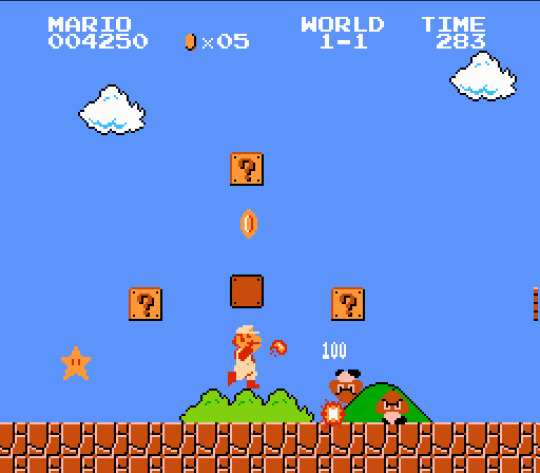
Let’s start with the most important part: the stuff that moves around and does things.
Now, I’ve looked at SMB1’s engine code, and it actually kind of sucks, so I’ll instead focus on a high-level version of a system that matches what SMB1 has, but doesn’t recreate it one to one. Remember, I want to encourage you to get something made yourself, in your own chosen language and framework, instead of getting stuck looking at hex and memory address behaviour.
We can define an object as something that’s interactable, and can change its state. This locks out stuff like the background bushes, clouds, mountains and also the ground (since it remains constant). However, this means that something like brick blocks and question mark blocks are objects.
In its simplest form, an object base would have a few parameters that every object in the game have: X and Y coordinates, current object state, and whether the object is active or not.
Most of the objects in SMB1 are either very boxy or actually just boxes, so for collision we’ll simply use an axis-aligned bounding box.
How you make the object do, you know, object things, probably depends on what language you’re using. In C I’d use some sort of overcomplicated function pointer array to point to object state functions. In more modern (and reasonable) languages like C#, Java and even C++ you’d probably just inherit the class and make the language figure out what to do with the object.
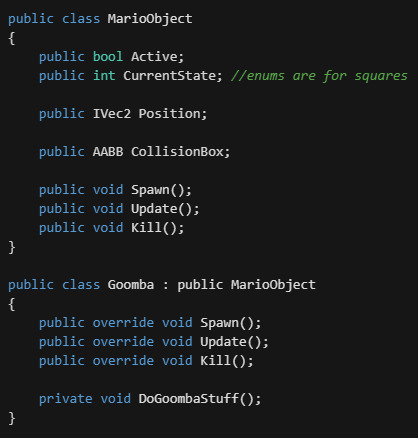
As for actually managing the objects, well that’s quite simple. The camera in SMB1 moves to the right, and never backtracks, so in essence you just have to worry about objects that appear from the right side of the screen. If you spawn objects only as they’d appear on the screen, and despawn them as soon as they disappear off the left side of the screen, you can easily get away with just a fixed-size array of say, 32 indices, and a for loop to update the active objects.

My very first game was quite literally just this. It’s as basic as it gets, and it totally works!
Level creation!
Generally speaking, one of the most frustrating parts in game development are level creation tools. Without a level, you don’t really have a game, and if your tools suck ass and level creation is a pain, your game won’t turn out so good. As of writing this, I’ve spent about 3 months writing a pretty comprehensive level editor for Radium. However, your first game (super mario) won’t be as complicated. We’ll use something tangible as an example again!
Let’s look at world 1-4, the first Bowser castle. At first glance it looks rather complicated, there’s floor, a ceiling, both change height at several points, there’s pits, all sorts of traps. It looks like a cohesive place.

But remember, video games are all smoke and mirrors. Ultimately all of this is just numbers in memory.
With that in mind, if you stare at the stage for a while, you might start noticing some strange details. Ignoring all enemies and simply looking at the ground, you might notice that the level never features any overlapping geometry. Bricks and question mark blocks may occasionally form platforms, but as far as the ground and ceiling goes, there are never any overhangs, tunnels, multi-layered passthroughs… it’s simply all solid blocks.
SMB1 constructs its worlds by defining a floor and ceiling height. The level itself is constructed by placing markers along the stage that change the floor and ceiling height from that point onward. If the floor is 0 grid units high, it’s a bottomless pit. Therefore, if you simply wanted to make a clone of the world generator and Mario’s player controller, the collision detection would at its simplest be whether or not Mario’s feet are below the ground level. For walls, you can scan the stage forward by Mario’s width and see if the ground level changes at all. If it does, you can check if it’s again higher than Mario’s feet level.
Thus, we have a level creation toolset that doesn’t even require tiles. It might not be suitable for a WYSIWYG approach to level design (for that I’d recommend Tiled or similar), but for a starting position you can quite literally just hardcode a list of ceiling/floor height change instructions separated by N amounts of tiles. Level design without an editor.
Conclusion
That’s not all I could talk about, but I already feel like this is a lot to swallow. Stuff like sprite batching, tile rendering, texture atlases etc. are all topics you'll probably encounter sooner or later. I'd really love to go on about stuff like this, but I'm trying to avoid writing a book.
My hopes with this post are to showcase that making games outside of the carefully curated toolsets of modern engines isn’t always as difficult as you’d imagine. The likes of Unity and Unreal have made us believe that game engines are gigantic, unscalable mountains of code. In truth, a game engine is simply something that runs a game.
When I started my engine journey in 2018, I hadn't really realized this. I jumped to MonoGame because I thought custom engines were rad, but I didn’t really know how to actually make an engine, let along a game in one. It didn’t take long to figure just how many corners you can cut to just make something work in the most basic of senses. For every challenge, you have infinite solutions, far beyond the templatized ones provided to you by online Unity tutorials.
I made the source code for my first ever custom game open when I finished the game. It was written in about 2 weeks, and during the production I learned MonoGame, C# and engine design philosophies, all for the first time in my life. You can take a gander at it here and witness it in all its hacky glory. Despite that, it’s a game that you can play.
I’ve also opened up the questions page on my Tumblr, so maybe I can assist with some issues you may have when starting out. I hope I’ve at least inspired you to give a shot for outside the box thinking. The game you want to make may be a lot simpler than you initially imagined.
Happy carefree programming!
5 notes
·
View notes
Text
Starhound: April Devlog
I've mentioned the RPGmaker game I'm working on a bit before, and since that's always gonna be pretty slow with me working full-time, I thought it'd be good to keep track of my pace with end-of-the-month progress posts. So! Here's what I've done in April.
(For the record, at the moment I'm actually planning on calling the game "Star Hound Vega", as the [Thing] [Descriptor] [Name] pattern is venerable among tokusatsu and mecha type heroes, but "Starhound" is my name for the setting and stories generally.)
Finished the first dungeon! It took more passes than I thought it would, as it always does, and I'm sure there'll be more tweaks in future, but I have now got to the point where I'm able to play through it and go "wow! that functions as intended without breaking! no notes"

2. Updated some sprites! Previously Vega's and Nemea's were just placeholders, but I've arrived at some that I feel pretty good about and represent them much better. Placeholders on the left, final sprites on the right:
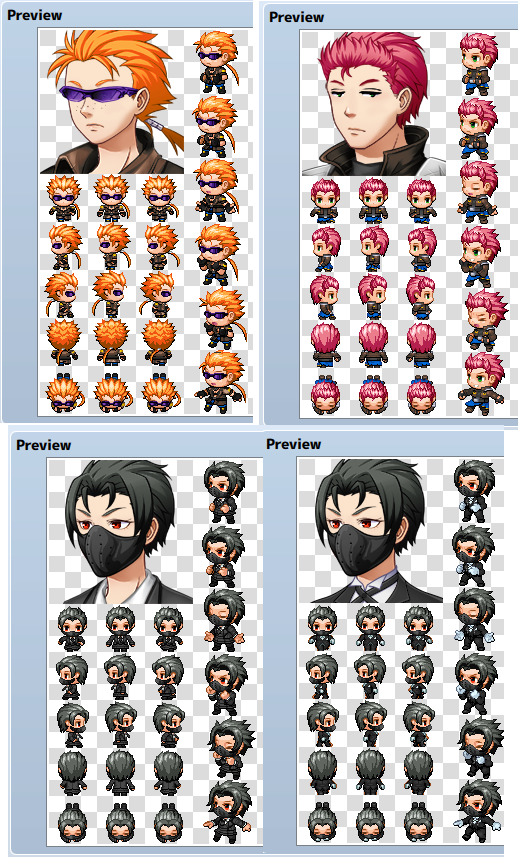
I ended up using the "male" creator for Vega, which I think works great for creating butch women. (I have hemmed and hawed a bit over if I'm being Problematic by doing this as she is also the main trans character, however: I am a trans girl and I can do what I want. In seriousness, it is a bit of wish-fulfilment for me--I wish I could be more butch and masc-styled and be read as "a handsome woman" and not "a man", so Vega's living that dream for me. She's a hunk you get it)
I will definitely still need some kind of custom visuals for Vega's henshin hero suit, and Nemea (and her boss, Princess Ascella) when she appears as an enemy.
3. Diversified the music! So a fun thing about RPGMaker is you think you know the small selection of default assets it gives you, but if you dig around in the installed files there's actually a lot more free assets you can transfer in--from walk sprites and portraits from older versions of RPGMaker, to a whole bunch of extra enemy graphics, to a lot more music. In particular, I found some pretty sweet battle themes so now each boss can have its own! (This all mixed in with something I already grabbed right when I started making this--a pack of specifically old toku style music, which is really great for making it feel appropriately flavoured.)
4. Added a town area! The overworld is pretty limited in this, it's not so much travel as using a small consistent hub/base to rest between dungeons (if sequels happen they'll probably be bigger but I'm trying to keep a lid on the minimum viable product scope ykno), but there are a couple additional areas, so...now we have that!

Got to have some fun populating it with cute characters, which was nice.
5. Started the second dungeon! My main goal this month was to finish the first one, so it's nice to be ahead of schedule.
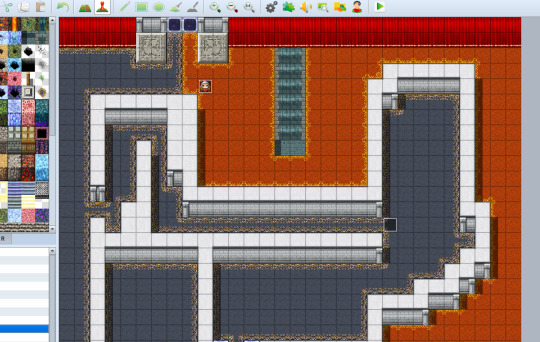
I've also figured out some really fun gimmicks for this one, so the first dungeon will serve mostly as a backdrop while you're introduced to the game's core mechanics, then this one will step it up and be more showy in its own right. Figuring out stuff like "oh you can have specific enemy encounters only happen on certain regions of the map" and "oh you can totally hide one-off boss fights inside random encounters" has got me to a concept I'm real happy with.
So yeah, that's where the game's at right now! For May, my main goal is just to finish the second dungeon, but we'll see where that goes. I plan on making a prototype build to toss at some friends once I've done a pass on the third dungeon (the total plan is for five, plus a final area after), but the third one is very short so I might even be able to do that in May too. But no pressure if the second is all I manage, that's the goal.
4 notes
·
View notes
Text
How to build and improve MVP for SaaS startup?
Almost every second SaaS product started as a great idea: a kick-ass concept destined to change the way the world functions. But what's next?
WHAT IS A MINIMUM VIABLE PRODUCT?
A Minimum Viable Product is [a] version of a new product which allows a team to collect the maximum amount of validated learning about customers with the least effort.
Imagine trying to hit a bullseye in a pitch black room. For starters, you don't know where the target is. Hell, there might not be a target.
So, before we can hit that bullseye, we'd need to conduct a few tests.
We'd need to:
Turn the lights on, and check that the target exists.
Try out a few different tools, and determine which was most accurate: a bow and arrow, a shotgun, or a sniper rifle.
Practice hitting the target, as chances are, our first few shots are going to miss.
Building, launching and scaling a new product is like trying to hit that bullseye: you can either build a finished product, straight from Day One, and hope that it hits the mark; or you can build your product in small, incremental steps, and test your assumptions at each stage. Also you can ask for help SaaS MVP development companies
DEVELOPMENT OF MVP FOR STARTUPS IS THE CHEAPEST AND EASIEST WAY TO VALIDATE YOUR IDEA OR BUSINESS MODEL
Budget-friendly
An MVP saves you a lot of money in the very begining of your jorney to successful product. MVP at the start point allows you decrease development costs so you can focus on attracting customers rather than spending money on designing of irrelevant features
Allay risks
Software development is a complex process that is full of traps, obstacles and pains in each step. MVP is the best way to mitigate most of the common risks and understand shape of final product and its way
GTM opportunities
MVP development goes rapidly, so you can let your customers estimate your product, focus on getting MVP in marketing sense and improve your startup to reach product-market fit
MVP development agency for SaaS can help you avoid common mistakes and save you ton of money and time!
MVP Development for SaaS companies with Palladium Agency
We are your closest friend and most reliable partner during any stage of your company's establishment and growth. Our passion is to see your business alive and profitable, and we are committed to achieving this goal. Closed startups with colossal potential are an unbelievable pain for our team, so we generate significant momentum to soar your company and help you make more and more customers happy!
2 notes
·
View notes
Text
Final Prototype: Spin to Win
For the final prototype, we were made to join groups and make some final improvements to one of the many games that had been made. After somewhat haphazardly joining a group with the three closest people around me, we managed to decide to work on someone elses project, aptly named "Spin to Win". Although I was a large fan of Asteroid Survivors, I do think that for the amount of time we have available, making a minimum viable product was somewhat unrealistic, particularly for a group that was somewhat made on the spot. In my opinion, this game was the best choice for a few reasons, which I'll be going over now.
The first reason is the premise. The idea for the game is that players control a rage fueled driver with a semi-invincible car, causing mayhem across the busy street by destroying everything in sight. This premise is not only simple and relatable to anyone who's been on the road before but it clearly states the conflict and objectives of the game. The enemy is every other car on the road and the objective is to make them explode. Additionally, the original creator had done a fantastic job of creating a visually satisfying which greatly supported this theme, launching cars that the player collided with in comedic fashion.

The second strength of the game is that it's simple. The only controls are moving left and right, making it simple to learn and allows playtesters to focus on the juicy systems rather than the controls. The rules of play are what makes games interesting and fun once you get past the novelty of making your character move around the screen so I believe it's best to focus on those being satisfying instead.
For the current weaknesses of the project, I would have to say that there are a few things. The game is too easy to start with, being almost impossible to fail as long as the player is paying attention. The second issue is that the amount of variance is lacking, with only one enemy type. The third is a lack of satisfying tension and release, as in the current version of the game it mostly comprises of a lukewarm, ever-present tension that slowly fades due to the lack of difficulty. Thankfully, these are things that can easily be improved. After some discussion within the group, we came to these changes to the game.
An overheat system. Currently the game is much too easy as the player can technically win by simply holding down left or right forever. Punishing players who spend all of their time spinning is important as it turns what is both the method to eliminate enemies and move into a resource that players have to mange. Overheating gradually reduces over time and can additionally be reduced by firetrucks, which are essentially reskinned cars with a bonus.
Additional enemies. The two that we plan to add are a variant of the car enemy which is immune to one direction of spinning and an enemy which is a missile that announces where it will land a short time before exploding on the road. Both of these are to add variance and increase the difficulty of enemies, serving as another thing to focus on.
Ramping difficulty. The frequency of special cars and missiles would increase with the difficulty alongside the speed of the whole game. The rate the player car would also overheat would increase. This would be based off of the player's highest combo multiplier, so less skilled players who drop their combos aren't throw into the deep end as quickly.
Obviously this includes additional tweaks to the combo system and scoring system alongside numerous other things, but those are the main three points for now. Hopefully it's not to difficult to implement.

After this will come some preliminary playtests before some additional tweaks. Ideally we get feedback that just requires tweaks but at this rate, who knows.
Hopefully everything works out!
0 notes
Text
What Is MVP in Software Development?
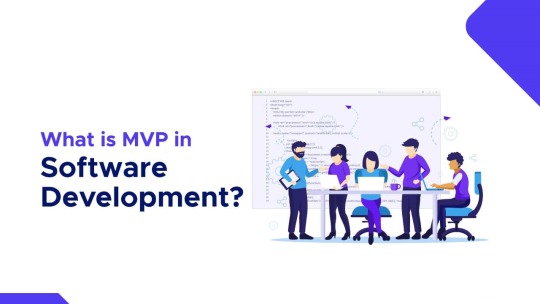
In the dynamic world of software development, the term MVP shines like a beacon, guiding businesses toward success. MVP, or Minimum Viable Product, is not just another tech buzzword but a powerful strategy to transform your software dreams into reality. Let's embark on a journey to unravel the mysteries of MVP, understand its importance, and explore how it can be a game-changer for aspiring businesses.
Understanding MVP
So, what exactly does MVP mean? MVP stands for "Minimum Viable Product." Don't let the word "minimum" fool you – it's not about offering less; instead, it's about offering the essentials. An MVP is the core version of your software that contains just enough features to meet the needs of early users and gather valuable feedback.
The Purpose of MVP
Why bother with an MVP? Imagine it as a testing ground for your ideas. It helps businesses save time and money by focusing on the fundamental aspects of a product before going all-in. The goal is simple:
Release a version quickly.
2. Learn from fundamental user interactions.
3. Refine the product based on that feedback.
In the world of software development, this approach is gold.
Components of an MVP
Building an MVP involves a careful selection of features. The core features are the must-haves, ensuring your product addresses the basic needs of users. Then come the additional features – the icing on the cake that enhances the user experience. Striking the right balance between simplicity and functionality is the key to a successful MVP.
Benefits of Using MVP in Software Development
Let's talk about the perks. First, speed – MVPs get you to market faster than traditional development methods. Why? Because you're not trying to build everything at once. This efficiency translates to cost-effectiveness. By focusing on the essentials, you save resources. The real gem, though, is the ability to gather user feedback early, helping you tweak and refine your product for maximum impact.
How to Build an MVP
1. Identify Your Target Audience
2. Define Core Features
3. Create a Basic Prototype
4. User Feedback and Testing
5. Iterate Based on Feedback
6. Repeat the Cycle:
7. Focus on Minimal Viable Product:
8. Monitoring and Analytics
9. Maintain Open Communication
10. Adapt and Pivot
11. Scale Gradually
Building an MVP app is a dynamic and iterative process. By following these steps, you create a feedback loop that allows your app to evolve in response to user needs, ensuring a more successful and user-centric final product.
Challenges in Implementing MVP
While the benefits are clear, challenges may arise. Balancing minimum features with user expectations can be tricky. There might be resistance to change within your team or organization. Acknowledge these challenges, but don't let them deter you. The rewards of a successful MVP far outweigh the hurdles.
Tips for a Successful MVP Implementation
1. Keep our MVP journey smooth.
2. Regularly seek and incorporate feedback – this is the lifeblood of MVP success.
3. Stay flexible and open to iteration.
Remember, the goal is not perfection from the start but continuous improvement based on real user experiences.
Conclusion
MVP in software development is not just a strategy; it's a mindset. It's about embracing the power of simplicity, speed, and user feedback. Whether you're a seasoned developer or an aspiring MVP app developer, integrating this approach into your strategy can be the key to unlocking success. So, don't just build software – build a journey, learn from it, and watch your ideas flourish.
0 notes
Text
A brief(ish) history of Cazadores
It has been a long road for Cazadores. Originally just a list of cool dragons from an eight-year-old, it's now being aimed at a future Kickstarter. So why not look at the past, to try and build some of that momentum towards the future?
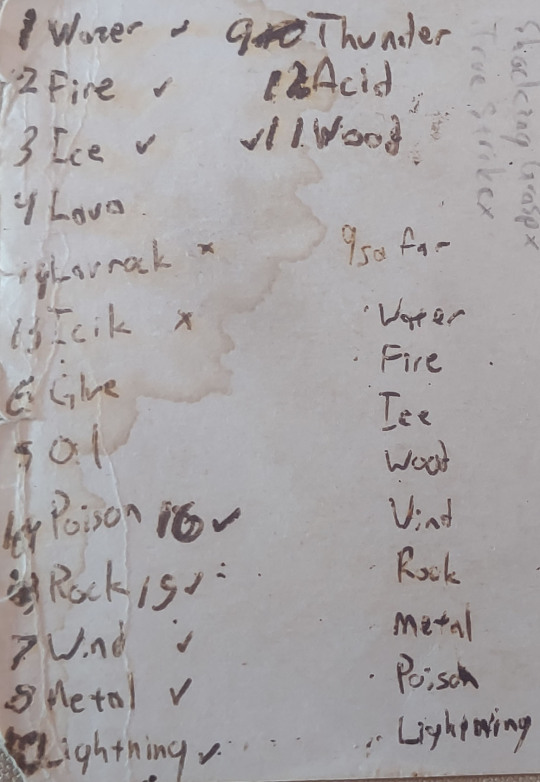
When I said it started as a note on cool types of dragons, I wasn't kidding. And on this grungy old index card is a list of elements for dragons - with such wonderfully bizzare names as "Lavrock" and "Icik." (Like Ice, but different.)
When a child asks if you design games, there's no reason not to listen - not only does it make them happy, but creativity peaks young - so it's a great way to get original ideas. While Icik hasn't made it into Cazadores, some basics of the game were actually hashed out at this time - the goal of the game was to fight a wide swath of monsters, and there would be a market where you would get elemental gear to help you do so.
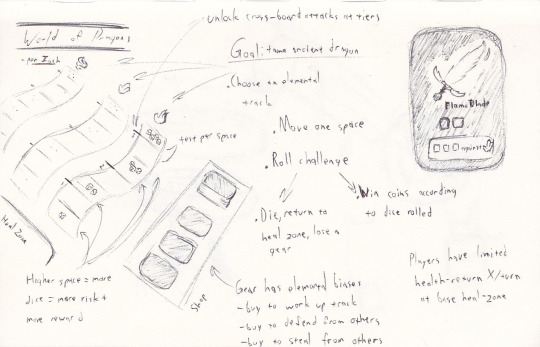
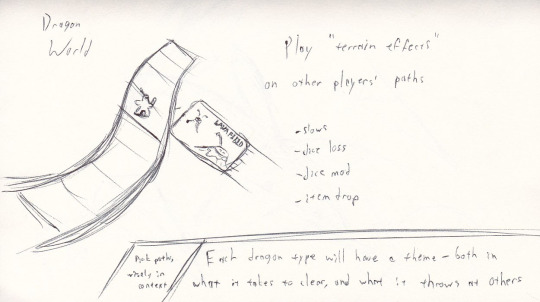

The game at this starting point was called "World of Dragons," and notably, had a number of tracks to fight along - one for each dragon in the game.
As early as the first few pages of notes however, the theme of inter-player tussling began to show its head. Partly arising as a way for players to interact despite the seperate tracks at this early stage, being able to play various effects on others sets the stage for all the meddling players are able to (and encouraged to) do in the current version of the game.

Another item that arrived early is the rule of "piggybacking." "Assisting" another player, (whether they want it or not,) in order to take part in their profits. An excellent source of inter-player meddling, this one rule has honestly been a thorn in my side ever since.
While regularly used by testers - sometimes to great effect - just writing this rule and its various edge cases in an intelligible manner has proved a continual pain.
On the other hand, once the emotional core of Cazadores was found - player-to-player meddling - the "piggybacking" action was found to exemplify this core a bit too well to just give up on... So the rewriting and re-rewriting continued.



In due time, the seperate tracks merged into one, and the mine showed up, flanked by the market and smithy. The market itsself would fade away, replaced by the smithy as the current market.
By the time that I started working on the first MVP (Minimum Viable Product) version of the game for physical testing, Cazadores was beginning to recognizably look like Cazadores - complete with the new name!
(As a complete aside, the name Cazadores - or "The Hunters" in Spanish - came to mind as there was a local restaurant with the same name. And now this arbitrary name chjange is driving research into the mythology of the Spanish-speaking world as we head into the latter phases of the design!)
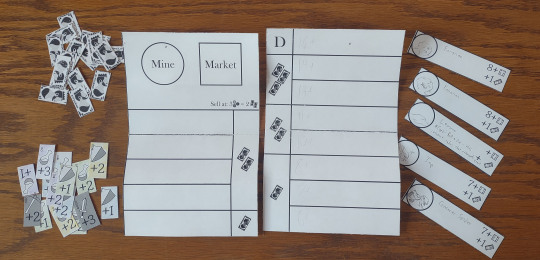
The MVP design is an absolute necessity in the design process - theory can only go so far before the game actually has to make the table. Once the board is on table and cards in hand you can actually see if the game WORKS.
It's suprising to me how massive faults can go completely unseen until actually playing the game through, step-by-step. In the past, more than one design has bit it at this step, simply becouase the implications of various actions were not considered, or taken to their logical conclusion. Thankfully, Cazadores pulled through, and design continued!
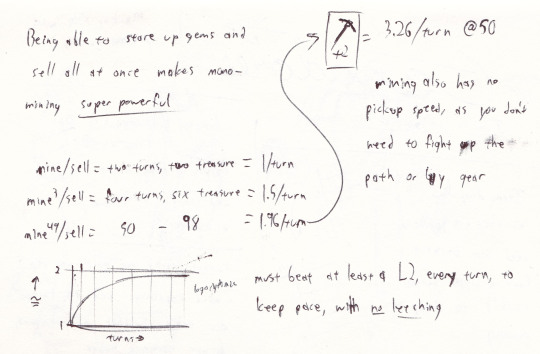
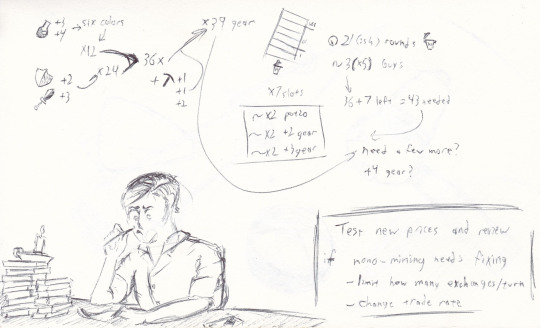
With the most basic of prototypes made, the amount of work - and notes - increases exponentially. And with it: the best part of game design - math.
Thankfully, while I may not have managed to achieve an engineering degree, game design generally doesn't need trigonometry to find holes in the design. Averages, earnings-per-turn, and action economy are fairly easy to figure out, but absolutely needed to be found at this basic lavel of testing, before anyone else so much as saw the game.
More than once, some strategies proved game-breakingly profitable, making the whole core of the game - hunting monsters - more of a secondary goal. But once the math was done and the game was balanced into a shaky, but stable position, it was time to test it with other people.




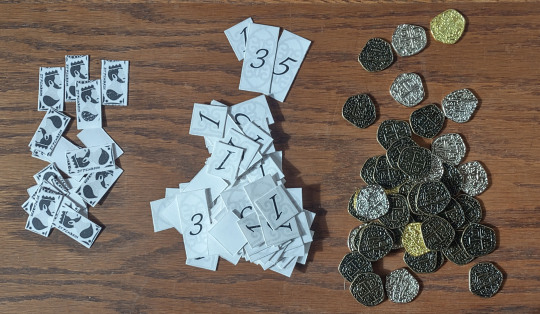
...and iterate. Print a new game, mark it up after one test, print a new one. Repeat ad infinitum. At this point, having a printer with a long-lasting toner cartridge rather than tempermental ink cartridges starts to pay off, because there is a LOT of printing.
Rules upon rules, boards upon boards, and so, so many item and monster cards. Black-and-white to start with, colored in by hand, and even the occaisional color print. Everything is temporary, and the priority is getting the fixes to the table - looks are a secondary concern.
And the game must make it to the table, as that's the only way to get the most valuable thing in the design process: player feedback. From family grinding out half a dozzen games on a snow day, to local groups trading soda for victory, to GenCon itsself, seeing people play this thing I made - it makes this long road worthwhile.
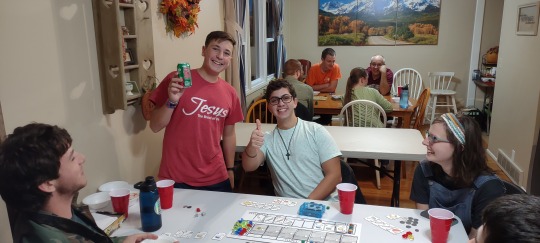
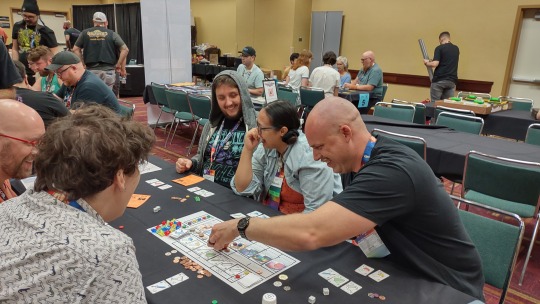
...and that's where we are now. The last rules are being balanced and added to the 1.5 edition of the rulebook, next year's convention season is being planned, and querries are being sent out to various production companies and others in order to plan the future. With any luck at all, next year I'll be writing a retrospective on a Kickstarter campaign!
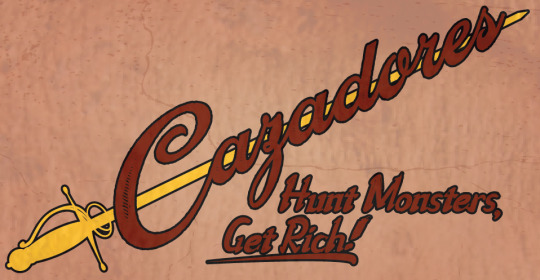
0 notes
Text
Prototype vs. MVP: Which One Do You Need?
A minimum viable product (MVP) is a releasable version of your software with enough core features to appeal to early adopters. The interaction of early adopters with an MVP allows you to get to know and understand your target audience and their expectations. You can also gauge how they accept your product and what features they enjoy and dislike. This approach allows you to build your product in small steps, collect feedback, and test your assumptions. Every release allows you to learn more about the users so that you can better address their pain points and needs by refining your product. According to the feedback you receive, it may be necessary to pivot, refocus on your core features, or start over with a brand-new product. Repeat these steps until your MVP is a fully-fledged, finished product.
Visit us:
#minimum viable product#ios app development#website development company#blockchain application development#best iphone app development#iot development services#ui and ux design service
0 notes
Text
1.What your original goal was for this course.
My goal for this course was to take the time management techniques I learned in my last class, and implement an optimal way to organize my time. I wanted to be able to use my time wisely in order to allow me the ability to do things like re-read, and try and understand the concepts fully. I wanted to be able to fully understand how I can utilize what I’ve learned, instead of regurgitating it for a grade. I came into this course wanting to understand the science behind these models and techniques.
2.How the goal was met by the course.
I was able to give myself plenty of time to marinate on the key concepts. Like I said before, I did a lot of re-reading and underlining. I even bought the audio version of “the lean startup “ so I can listen to it in the dark before bed. My goal was met becuase I was able to give myself enough time to actually learn, instead of waiting untilll the last minute to cram. I think time management is very important to model the weeks success, and I assume there will be many models I will learn that encompass a successful startup venture.
3.What you learned from this course.
I learned different models that can be utilized to provide a viable product or service. I learned how to think like an entrepreneur in this day and age. I feel I have more tools in my toolbox that will enhance my abilities. I specifically enjoyed learning about social entrepreneurship, and how I can go about providing a product or service that not only is profitable, but helps reduce things like carbon footprint. I can do that by using biodegradable packaging, all natural ingredients, employ felons and the homeless, donate a portion of the profits to a cause I like. Become involved in growing my community. I enjoyed learning about analog and antalog. The Sony Walkman bieng an antalog product. Apple (Steve Jobs) would be the antalog. How Jobs innovated a new product nobody knew they wanted. His bet was that Napster would be shut down by the FCC and that people would start wanting to pay for thier music. The model already is proven that people want to listen to music outside with headphones. Once the iPod was born, the Walkman didn’t have a chance.(The Lean startup, Eric Ries)
4.How you will apply the material learned in the course personally or professionally.
I will use what I’ve learned to enhance my business plan. I learned a lot about the science behind entrepreneurship, and how risky it can be if not introduced to a form of model. I learned that I will need to test my product as a hypothesis, create a minimum viable product, and improve on it through beta feedback. I want to research my competitors product and keep up on emerging trends. I want to identify my customers needs by asking them questions online. I want to rely on a model of testing a hypothesis using the scientific method. I want to utilize entrepreneurial management by setting learning milestones and record my progress. I want to set a goal to add value to people’s lives by offering a better product than what they buy now. In order to do this I will need to learn the most efficient way to educate consumers on wanting what they don’t know that they want, and why. I want to get behind my product %100 and believe in it so much that people will buy from me.
1 note
·
View note
Text
MarsDevs Presents 5 Standout Examples of Minimum Viable Products!
An MVP is an excellent step that helps you preview, decide, test, and finalize all the necessary adjustments your product requires to get going with its final version. It enables you to understand where you stand in this market so you do not get lost. So, in this blog, MarsDevs introduces you to the importance of an MVP, what it stands for, and the steps you need to consider before you develop one.
Click here to read more: https://www.marsdevs.com/blogs/marsdevs-presents-5-standout-examples-of-minimum-viable-products
0 notes
Text
Decade-Long MVPs: Building and Funding with 2030 in Sight
In the fast-paced world of mobile app development, making the right decisions is crucial for long-term success. As we look ahead to 2030, embracing an approach that ensures a successful Minimum Viable Product (MVP) launch and secures funding for sustainable growth becomes vital.
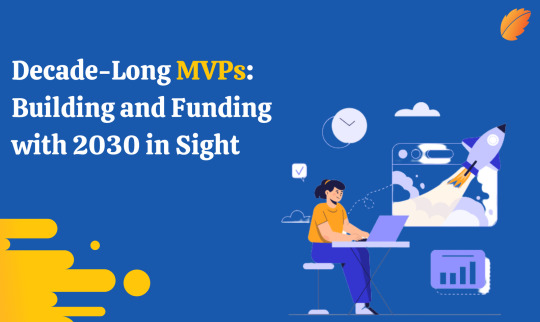
Building an MVP is not a novelty; it's a strategic choice with a proven track record. By focusing on core features, an MVP allows mobile app developers to test the market waters, gather valuable user feedback, and adapt their product roadmap based on real-world insights, minimizing risk.
Now, let's explore the world of MVPs - a driving force behind mobile app innovation and a significant route to realizing your app development goals.
Definition of MVP (Minimum Viable Product)
A mobile app's MVP is the initial version that includes only core features to address the primary needs of its target audience. The primary objective is to validate the product idea with real users while minimizing the time, effort, and resources invested in development.
According to a study conducted by CB Insights, which surveyed over 2,000 startups, the average duration to develop an MVP is approximately 6 months.
As we consider the decade-long MVP perspective, a transformative narrative emerges. Beyond its conventional virtues, an MVP extending its impact over a decade underscores its robustness.
This approach, infused with longevity, delves deep into the annals of app evolution, demonstrating its prowess constantly aligning with the evolving user- landscape.
The decade-long MVP embodies not only the principles of user validation but also the tenacity to persistently refine and reinvent, keeping in stride with the dynamics tides of the digital era.
Opting for an MVP approach significantly reduces risks associated with new product launches, allowing for valuable user feedback early in the development cycle, empowering informed decisions, and refining the product according to actual user needs.

Why Consider MVP for Mobile App Development?
A. What is an MVP, and How Does it Differ from a Full-Fledged App
When it comes to mobile app development, MVP stands for Minimum Viable Product. It is a strategic approach that involves developing a simplified version of the app with only the core features essential for its basic functionality. This approach is in contrast to building a full-fledged app that includes all envisioned features.
The key difference between an MVP and a full-fledged app lies in the scope and complexity. An MVP focuses on the fundamental features, whereas a full-fledged app incorporates a wide range of functionalities, often making it more complex and time-consuming to develop.
B.Advantages of Building an MVP for Mobile App Development
Cost-effectiveness:
Building an MVP is a prudent financial decision, especially for startups and small businesses. By focusing on the essential features, development costs are significantly reduced, allowing you to allocate resources more efficiently.
This approach minimizes the risk of investing heavily in a product that might not resonate with the target audience.
Faster Time-to-Market:
In the fast-paced digital landscape, getting your mobile app to the market quickly is crucial for success. With an MVP, you can expedite the development process and launch the core product sooner.
By doing so, you gain an early advantage, establish your presence, and start acquiring valuable user feedback.
Risk Reduction:
Developing a full-fledged mobile app solution without initial market validation can be risky.
By opting for an MVP, you mitigate this risk by validating your idea with real user interactions. If the feedback is positive, you can confidently invest in further development, knowing that there is demand for your product.
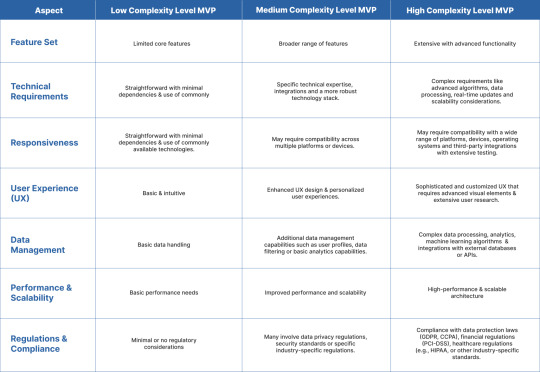
Designing the MVP Architecture for 2030: Essential Steps and Considerations
A. Evaluating Long-term Market Trends and User Needs
To build an MVP that stands the test of time and leads to successful mobile app development, it's crucial, to begin with, a clear understanding of the long-term market trends and user needs.
This will enable you to create a product that remains relevant and competitive for years to come.
Analyzing Emerging Technologies and Industry Shifts
Staying abreast of emerging technologies and industry shifts is essential in ensuring your MVP remains innovative and adaptive. Consider how advancements in AI, AR/VR, blockchain, or other disruptive technologies could impact your app's functionality and value proposition.
By incorporating relevant features from these technologies into your MVP, you can enhance user experience and cater to future demands.

Conducting Market Research and Competitive Analysis
Market research is the bedrock of any successful MVP. Analyze market trends, customer preferences, and pain points to identify gaps your MVP can fill effectively.
Moreover, conduct a comprehensive competitive analysis to understand what other solutions are available and how your MVP can differentiate itself. Strive to create a unique selling proposition that addresses unmet needs and entices users to choose your mobile app solution over competitors.
B. Crafting a Unique Value Proposition for the MVP and Beyond
A compelling value proposition is key to convincing users that your MVP is worth their time and attention. Your MVP should be built around solving a specific problem or offering a distinct advantage that resonates with the target audience.
Consider how your mobile app can improve users' lives or streamline their processes like no other product. Focus on communicating the unique benefits clearly and concisely to potential users.
C. Targeting the Right Customer Segments and User Personas for the Future
Identifying and targeting the right customer segments and user personas are vital steps in maximizing your MVP's potential for conversion and lead generation. Conduct in-depth research to understand your target audience's preferences, pain points, and behaviors. Use this information to design a user-centric MVP that caters to their specific needs and preferences.
Additionally, anticipate how customer segments may evolve in the future and build scalability into your MVP to accommodate these changes.

D. Leveraging Agile Development Methodology
Agile development remains a proven methodology for MVP projects. Its iterative approach allows quick adaptations to changing requirements, reducing development time and enhancing overall efficiency. Embrace Agile practices to foster collaboration between development teams, stakeholders, and end-users, leading to better outcomes.
As we set our sights on 2030, the MVP approach emerges as an optimal choice for mobile app development. Its ability to strike a balance between delivering value and gathering user feedback allows for continuous improvement, keeping your app relevant and competitive.
Remember, the journey towards building a decade-long MVP may pose challenges, but embracing these essential steps and considerations will pave the way for a sustainable and thriving mobile app that resonates with users and drives conversions
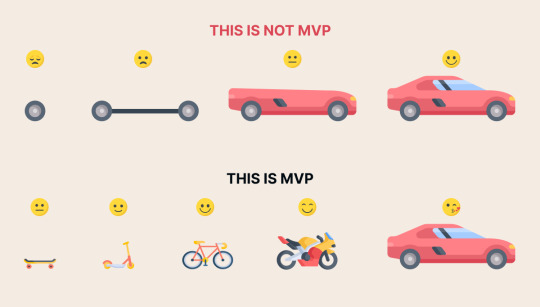
Funding Strategies for Long-term Success in Decade-Long MVPs
As we delve into the exciting world of Decade-Long MVPs and their impact on mobile app development, it's crucial to discuss funding strategies that ensure long-term success.
Let’s explore proven approaches to securing financial support for your MVP with an eye on 2030 and beyond.
Seed Funding with Scalability in Mind
When seeking initial funding for your Decade-Long MVP, it's vital to present a clear and compelling vision of your app's scalability. Potential investors are drawn to projects that demonstrate the ability to grow and adapt over the years. Focus on showcasing how your MVP will evolve into a full-fledged solution, captivating a broader user base and attracting additional funding opportunities.
Embrace Lean Development for Cost Efficiency
A paramount aspect of funding strategies for Decade-Long MVPs is to adopt lean development practices. Investors are attracted to startups that can efficiently utilize resources while achieving significant milestones. Employing lean methodologies not only minimizes costs during the MVP phase but also sets a foundation for controlled growth and long-term sustainability.
Prioritize Product-Market Fit Validation
Before embarking on the funding journey, ensure that you have solidified your product-market fit. Investors are more likely to invest in an MVP that has already validated its value proposition with real-world users. Demonstrating a strong product-market fit instills confidence in potential backers, leading to better funding prospects.
4. Leverage Strategic Partnerships
Strategic partnerships can be a game-changer when it comes to funding your Decade-Long MVP. Collaborating with established players in your industry not only provides financial support but also opens doors to valuable expertise, resources, and a broader user base. Seek partnerships that align with your long-term vision, enhancing the chances of success for both parties involved.
5. Consider Venture Debt as an Option
Venture debt can be an attractive funding option for Decade-Long MVPs. Unlike equity financing, venture debt allows you to raise capital without diluting your ownership stake significantly. However, it's essential to use venture debt judiciously, ensuring that you have a solid repayment plan in place to avoid unnecessary financial strain.
MVP Success Stories Across Different Industries
Case Study: Snapchat - A Triumph of MVP-driven Innovation in Visual Social Media
In 2011, Snapchat redefined social media with its visual experiences. Snap Inc., the company behind it, now earns exceeding $1.07 billion annually, engaging 186 million smartphone users.
Co-founder Reggie Brown's visionary idea birthed Snapchat. Its first version, an iOS app named Picaboo, allowed photo sharing with a timed viewing limit.
Snapchat's MVP journey commenced with 1000 users in six months. The founders harnessed MVP to test assumptions, and understanding market preferences. Their innovation of self-destructing videos, later "Stories," amplified growth, captivating global audiences.
Key Problems Addressed:
Snapchat's MVP successfully tackled a significant challenge that traditional social media platforms posed: the lack of privacy and traceability. By allowing users to share content with a finite lifespan, Snapchat introduced an element of authenticity and temporal intimacy to the social media landscape.
MVP Features:
1. iOS App: The initial MVP was a minimalist iOS app focused on testing the core idea of ephemeral photo sharing.
2. Photo Sharing: The MVP's primary function allowed users to share photos with friends, which served as the foundation for Snapchat's unique content-sharing approach.
3. Expiration Timer: A crucial element of the MVP, the expiration timer added a temporary nature to the shared photos, creating a sense of urgency and excitement.
Key Features Introduced Post MVP Validation:
Building upon the validation and success of their MVP, Snapchat introduced a series of impactful features, further solidifying its position as a visual social media powerhouse:
1. Stories: The breakthrough "Stories" feature enabled users to share a collection of self-destructing photos and videos, forming a captivating narrative of their day-to-day experiences.
2. Poke: An early addition, "Poke," allowed users to send short messages, complementing the temporary nature of the app.
3. Replay: With "Replay," Snapchat addressed the desire for users to view a Snap one more time before it disappeared.
4. Geofilters: These location-based overlays enabled users to add context and creativity to their Snaps, connecting content to specific geographical areas.
5. Face Filters: A beloved feature that transformed selfies with entertaining and interactive augmented reality filters.
6. Memories: Introduced to allow users to save their Snaps and Stories, preserving cherished memories for future reminiscing.
Snapchat is a shining example of successful MVP implementation, where the founders astutely leveraged early versions to understand and cater to their market's desires. By thoughtfully iterating and introducing innovative features post-MVP, Snapchat revolutionized visual social media, captivating millions worldwide with its engaging and time-bound content-sharing experience. This case study underscores the invaluable impact of MVP-driven innovation in propelling businesses to achieve global dominance in the rapidly evolving landscape of mobile app development.
Key Takeaway-
Achieve MVP-Driven Triumph with Consagous Technologies by Your Side!
As we look ahead to 2030, the mobile app landscape is poised for continuous evolution, demanding innovative and efficient solutions. For businesses seeking to navigate this dynamic terrain, Consagous Technologies emerges as a premium mobile app development company. With a proven track record of delivering exceptional MVP-driven solutions, Consagous Technologies stands ready to empower businesses with scalable, user-centric, and cutting-edge mobile apps.
It's important to note that the concept of an MVP doesn't mean it's designed to last a whole decade on its own. Instead, it's a constant journey of testing, refining, and adjusting to stay relevant over time.
By embracing the MVP philosophy and teaming up with Consagous Technologies, your business can set off on a great adventure in developing mobile app development solutions. This collaboration isn't just about making things smoother – it promises real, tangible results like more sales, more leads, and a stronger presence in the ever-changing mobile app world. Together, let's explore the incredible potential that MVP-driven success offers, guiding us through the exciting years ahead. Explore our MVP solutions today!
FAQs
1. What is an MVP, and why is it crucial for mobile app development?
A: An MVP, or Minimum Viable Product, is the initial version of a mobile app that includes the core features necessary to satisfy early users and gather valuable feedback.
It allows businesses to validate their app idea, minimize risks, and make informed decisions before investing heavily in total development. Incorporating an MVP approach in mobile app development enables companies to save time, resources and ensure the final product meets users' needs.
2. How does building an MVP impact a company's growth and funding opportunities?
A: Building an MVP can significantly impact a company's growth and funding prospects. Investors often favor startups that have validated their concept through an MVP, showcasing the product's potential and market fit.
By demonstrating early traction and user engagement data from the MVP, companies can attract more funding and strategic partnerships. Additionally, the iterative nature of MVPs allows companies to continuously refine their mobile app solution continuously, enhancing their appeal and increasing the chances of a successful product launch.
3. What are some real-world examples of successful companies that began with MVPs?
A- Several industry-leading companies started their journey with MVPs, highlighting the strategy's effectiveness.
For instance, Snapchat, the visual social media giant, began as "Picaboo," an MVP allowing users to send disappearing photos. Uber, the global ride-hailing giant, tested the waters with a simple MVP connecting iPhone users with cab drivers. Airbnb started with a basic landing page MVP, showcasing apartment pictures to gauge interest.
These real-world examples demonstrate how MVPs have paved the way for success and led to massive growth in the highly competitive mobile app market.
0 notes
Text
4 Ways to Attract Investors for Your New App or Digital Product
How many startups, growing tech companies, and talented entrepreneurs have faced the same dilemma? They’re inspired by a vision of an innovative new application or digital product but lack the resources to make it a reality. As competitive and fast-paced as the market is, building and launching your app as quickly as possible is essential. If you’re facing this situation, the question is—how can you attract investors to provide the funds you need for your app to succeed? The answer very likely lies in a partnership with a development studio recognized for expertise in MVP development services, exploring new tech, and beyond.

Partner with an Effective Development Studio
Partnering with an experienced, effective tech development partner is the best first step to get your app off the ground. A first-rate development partner can work with you to design, build, launch, and scale your product every step of the way. Beyond those crucial practical services, an established partner will have the experience and connections in the industry that makes them an invaluable resource for advice, guidance, insights, and perspectives you’d be hard-pressed to find so conveniently anywhere else.
Building an MVP Is a Must
What do all the titans of the tech industry have in common? They all started with a minimum viable product (MVP) version of their app or business model. An MVP is essential for testing, gaining critical user feedback, saving money by shortening your production cycle, and attracting investors. Being able to interact with this first version of your product is arguably the most effective demonstration of its potential. It’s also another reason to find a development partner that has proven experience in MVP services.
Focus on Your App’s Niche
It can’t hurt to contact individuals or organizations that could conceivably help fund your digital product. A variety of innovative products and applications have successfully secured funding by reaching out through the big crowdfunding sources. However, knowing your niche and your target audience is crucial. For one, focusing on your app’s niche can help identify potential investors within that niche who are more likely to be enthusiastic about your idea. Nailing down your target demographic is also useful for branding your digital product more effectively. With your audience branding strategy sorted out, fine-tune your elevator pitch for investors accordingly and build out a clear, straightforward pitch deck.
Incorporate Augmented Reality
If there’s one way to capture the attention of private investors, venture capitalists, and incubators capable of funding your digital product, it’s incorporating the latest tech trends. For instance, augmented reality and the Metaverse are the future of tech applications. That makes them more than a flashy trend—they are a huge market with almost limitless potential. Ensure that the development partner you choose offers a skilled team with expertise in augmented reality services, and consider whether AR or Metaverse compatibility would make your digital product even more dynamic as you search for investors.
About Tintash
The story of how Tintash was founded is pure Silicon Valley. The founders prototyped their vision for this innovative development studio in 2007 over the famous coffee cake at Hobee’s in Palo Alto. Now, they are a dynamic partner that helps promising startups, aspiring entrepreneurs, and growing companies bring their vision to life. They make it all happen with an elite group of dedicated remote team members led by Stanford, Harvard, Apple, and PayPal Alumni. With over a decade of experience, Tintash has become an industry leader thanks to their transparency, proficiency, and communication across verticals. If your organization is looking for a partner to assist with web, application, MVP, or blockchain development services, trust Tintash to help your business succeed.
Optimize your digital product and enjoy a successful launch with help from https://tintash.com/
Original Source: https://bit.ly/44nI0V8
0 notes